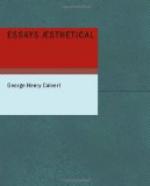Not less than men of talent men of genius need to cultivate style; nay, from the copiousness and variousness of their material, and from its very inwardness, the molds into which it is to be thrown need the finest care. Coleridge, rich and incomparable as he is, would have made many of his prose pages still more effective by a studious supervision; and De Quincey tells us what labor his periods sometimes cost him. The following advice, given in a letter from Maurice de Guerin to his sister, may be addressed to all literary aspirants: “Form for yourself a style which shall be the expression of yourself. Study our French language by attentive reading, making it your care to mark constructions, turns of expression, delicacies of style, but without ever adopting the manner of any master. In the works of these masters we must learn our language, but we must use it each in our own fashion.”
One of the first constituents of a good style is what Coleridge calls “progressive transition,” which implies a dynamic force, a propulsive movement, behind the pen. Hazlitt, for example, somewhat lacked this force, and hence De Quincey is justified to speak of his solitary flashes of thought, his “brilliancy, seen chiefly in separate splinterings of phrase or image, which throw upon the eye a vitreous scintillation for a moment.” One of the charms, in a high sense, of Coleridge’s page is that in him this dynamic force was present in liveliest action. His intellect, ever enkindled by his emotions, exacted logical sequence, and thus a rapid forward movement is overspread by a glow of generous feeling, which, being refined by his poetic sensibility made his style luminous and flowing.
De Quincey, treating of aphoristic writing, says, “Any man [he of course means any man with good things in him] as he walks through the streets may contrive to jot down an independent thought, a short-hand memorandum of a great truth; but the labor of composition begins when you have to put your separate threads of thought into a loom; to weave them into a continuous whole; to connect, to introduce them; to blow them out or expand them; to carry them to a close.” Buffon attached the greatest importance to sequence,




